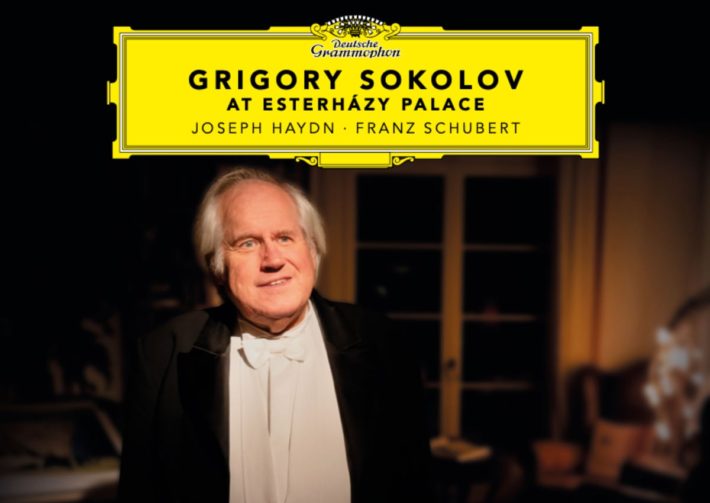Grigory Sokolov’s new release is a live recording from the Esterházy Palace: fittingly features in the first half is Haydn. The composer spent more than 30 years as the Kapellmeister for the Esterházy family and wrote (among other things) a large portion of his piano sonatas. In the second half, another Austrian compatriot–Franz Schubert–takes center stage. Schubert was greatly influenced by Haydn; indeed, his Op. 142 Impromptus reflect the refined elegance of his predecessor.
Of the three Haydn Sturm and Drang sonatas presented, the No. 47 Op. B minor is a highlight. Sokolov shows both comfort with and command of the small details in the Allegro Moderato (track 3), with crisp dotted notes and tight trills. The arrival of the grand D major section is invigorating with assertively rolled chords in the left hand. The Minuet of the middle movement is graceful and coy; here, the pianist pays special attention to how the small but recurring descending-line motif connects the upper and lower voices. The Finale has lovely color changes and impeccable clarity and a sense of unshakeable assurance even in the fastest passages.
Some sources believe that Schubert’s Op. 142 Impromptus reflect a 4-movement sonata form. If one goes by the key relationships and even the character of each work, there is tangible validity to this perspective. Sokolov maintains a level of restraint throughout the set which proves to be both a boon and a problem. On one hand, his masterful tone control complements Schubert’s refined style. On the other hand, I really hoped for more distinction between each individual work. Take, for instance, the two outer F minor Impromptus: in the first (track 9), Schubert imbues a sense of dynamic tragedy in the opening that then transforms into a lighter character at the arrival of the major key (1’03”). While Sokolov grasps the grandeur of the initial phrases, the slow tempo really takes away a much-needed momentum. The A-flat major section sounds far too similar in character to the transitional material that comes before. Radu Lupu’s fine recording from the 80s is my go-to here: the dramatic parts are much more captivating and the transitions between sections have plenty of nuance but also the necessary hints of suspense.
Related Posts
- Review: Grigory Sokolov Plays Beethoven, Brahms, Mozart
- Review: Schubert – Impromptus, Moments Musicaux – Alexandre Tharaud, Piano
- Review: Vikingur Ólafsson Plays Rameau and Debussy
The second F minor Impromptu (track 12) is compositionally more playful and dancelike. Sokolov has a fine variety of tone – round and mellow in the softer moments but stinging in the ‘outbursts’ (i.e. 0’51”) – but the work feels more like a continuation and not a contrast to the first Impromptu. Again, it moves at too relaxed a pace to effectively capture Schubert’s “scherzando” marking, so the staccatos and defining off-beat accents have a very watered down feel. Maria João Pires’ 1990s account might be too speedy for some, but it leaves a most memorable impression with its crisp articulation and firecracker personality.
The encores tie into the central program through their continued inclusion of Schubert, but there’s also variety with the inclusion of Rameau and Alexander Griboyedov, among others. Rameau’s Rappel des Oiseaux (track 14) is excellent not only in how realistically it recreates the chatter of the birds but also in how Sokolov delivers a lovely sheen to the filigree passages. Groboyedov’s E minor Waltz (track 11), languid and dreamy in its most gentle moments, has a surprise in store in its unabashedly declamatory middle section. The final encore, Debussy’s des Pas sur la Neige, is an interesting choice when most pianists might conclude with more of a virtuosic flourish, but it makes sense given the rest of the programming. The pianist introduces the right amount of disquietude and movement into the arresting soundscape.
The sound engineering highlights many nice qualities–Sokolov’s sophistication of soft dynamics, the velvety tone of the Steinway D, and the round acoustics of the Esterházy space. The liner notes follow a more biographical than musically analytic path (a tad more of the latter would be nice) but do well to explain how Haydn and Schubert come together in the program.
In sum, there is much to appreciate in Sokolov’s artistry, especially in the Haydn. However, those looking for a more vibrant and memorable listening experience of the Schubert will want to refer to other recordings.

Review: Grigory Sokolov at Esterházy Palace
Deutsche Grammophon, CD 4861849
Recommended Comparisons
Bavouzet | Brendel | Pires | Lupu
Read more classical music reviews or visit The Classic Review Amazon store
Follow Us and Comment:
[wd_hustle id=”HustlePostEmbed” type=”embedded”]











